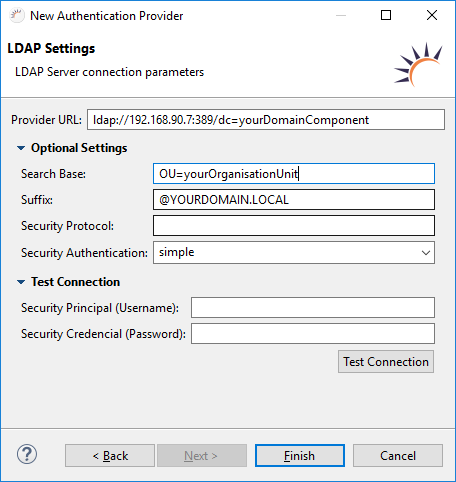LDAP as data source for authentication
| This continues the Wizard to create an Authentication Provider |
-
Enter the URL of your LDAP server at Provider URL.
-
Enter the appropriate parameters for your LDAP server in Optional Settings.
-
Click Finish.

Options:
-
Optional Settings
-
Search Base - Defines where in the directory the LDAP search starts.
-
CN - commonName.
-
L - localityName.
-
ST - stateOrProvinceName.
-
O - organizationName.
-
OU - organizationalUnitName.
-
C - countryName.
-
STREET - streetAddress.
-
DC - domainComponent.
-
UID - userid.
-
-
Suffix - Root, topmost data object of an LDAP data structure.
-
Scurity Protocol - Optional security protocol (e.g. SASL, SSL).
-
Security Authentication - Standard Security Protocol (none / simple / SASL)
-
-
Test Connection - Own access data. Only necessary to test the connection.
Example:
package com.company.example.business;
import javax.naming.directory.DirContext;
import com.xdev.security.authentication.Authenticator;
import com.xdev.security.authentication.AuthenticatorProvider;
import com.xdev.security.authentication.CredentialsUsernamePassword;
import com.xdev.security.authentication.ldap.LDAPAuthenticator;
import com.xdev.security.authentication.ldap.LDAPConfiguration.LDAPConfigurationBuilder;
public class MyAuthenticationProvider implements AuthenticatorProvider<CredentialsUsernamePassword, DirContext> {
private static MyAuthenticationProvider INSTANCE;
public static MyAuthenticationProvider getInstance() {
if (INSTANCE == null) {
INSTANCE = new MyAuthenticationProvider();
}
return INSTANCE;
}
private LDAPAuthenticator authenticator;
private MyAuthenticationProvider() {
}
@Override
public Authenticator<CredentialsUsernamePassword, DirContext> provideAuthenticator() {
if (this.authenticator == null) {
this.authenticator = new LDAPAuthenticator(
new LDAPConfigurationBuilder("ldap://192.168.90.7:389/dc=yourDomainComponent,dc=local")
.searchBase("OU=SBSUsers,OU=Users,OU=MyBusiness").suffix("@YOURDOMAIN.LOCAL")
.securityAuthentication("simple").build());
}
return this.authenticator;
}
}